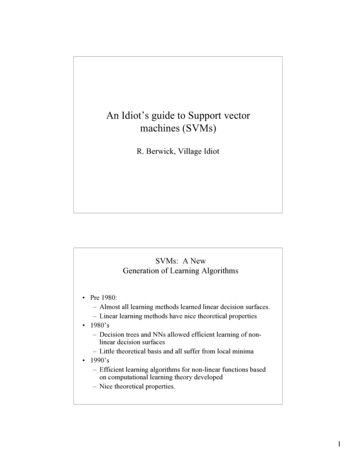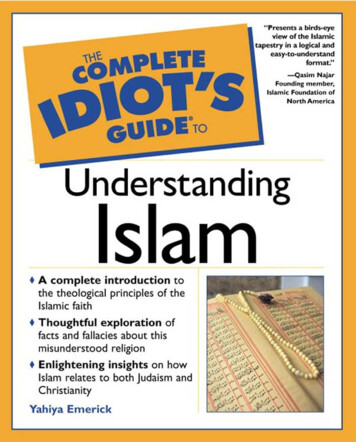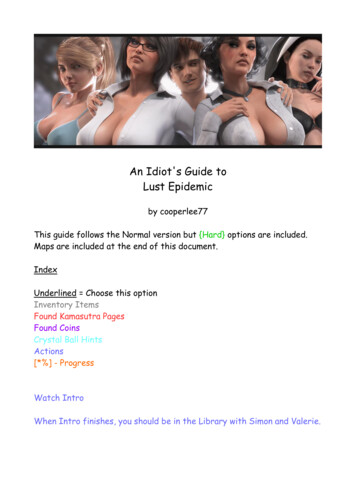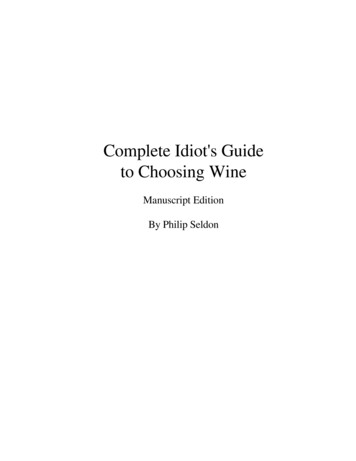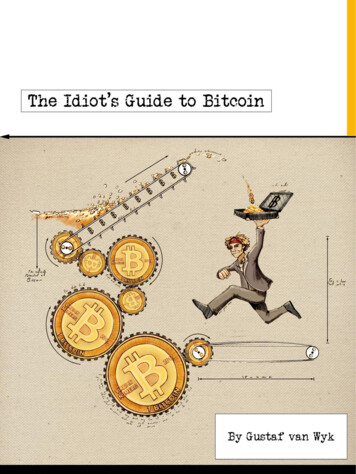
Transcription
The Idiot’s Guide to BitcoinGustaf van WykAll Rights ReservedChaos PublicationsDisclaimer: e material in this publication is of the nature of general comment only, and does not repstances and it should not be relied on as the basis for any decision to take action or not totake action on any matter which it covers. Readers should obtain professional advice whereappropriate, before making any such decision. To the maximum extent of the law, the author and publisher disclaim all responsibility and liability to any person, arising directly orindirectly from any person taking or not taking action based upon the information in thispublication.
ContentsContentsForeword-iAbout this-iiiStart here-vPart 1 - MONEYChapter 1 - What the Heck is Money, and Why Doesn’t AnyoneCare About it During a Zombie Apocalypse?Chapter 2 - Our Current Monetary System, Paper Currency,Centralized Banking and Debt.112Part 2 - BITCOINChapter 3 - WHAT IS BITCOIN How Bitcoin is changing the World What is Cryptocurrency The Rise of Bitcoin Legitimacy Decentralization It’s like Gold, but Better232426272830Chapter 4 - HOW BITCOIN WORKS Bitcoin Creation What can Bitcoins be used for323334
Idiot’s guide to BitcoinChapter 5 - BUYING & SELLING BITCOIN How it’s Done The Bitcoin Wallet Paper wallets AKA “Cold Storage” Software Wallets Mobile Wallets Web Wallets Transferring Bitcoins between Wallets Buying Bitcoins Bitcoin Exchanges Selling Bitcoins37383942444546474855Chapter 6 - TRADING BITCOIN The Bitcoin Economy The Psychology of Trading Bitcoin Trading Basics Live Bitcoin Market Charts Helpful Mobile Apps Forums and the Bitcoin Community Set your alerts and search for Info Daily Buy Low, Sell High606163666770717272Chapter 7 - SPENDING, ACCEPTING AND PROMOTING BITCOIN Spending Bitcoin Online Donating Bitcoins Spending Bitcoins Offline Accepting Bitcoins as a merchant7375757676Chapter 8 - MINING BITCOIN Thar’ be Gold in Them thar’ Hills! How Mining Works in a Nutshell Bitcoin Mining Hardware Bitcoin Mining Software Mining Pools8283858788QUESTIONS & CONCERNS I’m Afraid Bitcoin will be hacked - everythingcan be hacked! Will The Government Shut Down Bitcoin? Is Bitcoin Just a Bubble Waiting to Burst?CONCLUSION89919295
ForwordForewordThe ‘Idiot’s Guide to Bitcoin’ provides you with an integralunderstanding of the digital currency known as Bitcoin which isrevolutionizing the way we think about money. It explains everythingyou need to know to get involved, from beginning to end.Though this book is part of a larger movement towards economicfreedom it focuses absolutely on making Bitcoin easy. At rst glancedigital currency might seem like a small and exclusive movementon the internet that might not have uses beyond those of today’slaptop-investors and cyberpunks. The ‘Idiot’s Guide to Bitcoin’ aimsto demonstrate how important this change in the way we think aboutmoney is and most of all to show you how easy it is for you to get involved.The book starts by discussing the main principles of Bitcoin as well assome of the more politico-economic implications of the revolution.These are covered in depth but the book is designed in such a way thatthese can easily be skipped in case you are more interested in gettingto the nitty gritty of things right from the start. There are some technicalparts to understanding Bitcoin and the book covers these in an easyto follow, step-by-step fashion. There are ten chapters in all and everychapter covers a different aspect of Bitcoin in the most appropriatefashion. Nothing is left out.The implications of a Revolution, and Bitcoin IS a revolution, is oftenuncertain and shrouded in rumour and conjecture. The Idiot’s Guideto Bitcoin deals with all the concerns surrounding Bitcoin on a factualbasis and strives to inspire con dence in you by giving you a soundunderstanding of everything Bitcoin and provide you with resourcesthat you can turn to when in doubt.i
What the Heck is Money, .?Idiot’s guide to BitcoinForewordI wrote the Idiot’s Guide to Bitcoin with you in mind. I’ve tried to bestsupport the Bitcoin movement by making it easy and accessible foreveryone. I want you to experience rsthand, as I have, the bene tsof Bitcoin as a currency as well as a commodity. I wanted to show youthe freedom that Bitcoin offers and that the returns are nothing short ofmagni cent. I wanted to be the one to introduce you to our future! SoI wrote the Idiot’s Guide to Bitcoin.What you read in these pages could set you free and give youcon dence that the future of global economics is not dire. Not tomention the nancial gains that stand to be made as the relative youngeconomy grows and its value increases. So I encourage you to grab thisopportunity with both hands and join us in making the world a freer andwealthier place for everyone.Wishing you freedom and prosperityGustaf van Wykii
AboutAbout this.Almost two years ago I was made aware of Bitcoin as an anonymousway to make payments. At the time Bitcoin’s value as a meansof exchange seemed to be very much linked to the clandestinedepths of the internet. It’s was trading at below 10 for one and didn’tlook like much but on that fateful day the larger implications of Bitcoindawned on me.I have always maintained a strong philosophical approach to life andas such have resolved to stand for that one and only absolute right ofman that is freedom. I had been aware of the dictatorship-like formof the global nancial situation for a long time. Centralized banking isa curse on modern life, a poorly disguised form of good ol’ slavery inthe form of self-perpetuating debt and everybody knows it, right. Yetdespite a pervasive awareness of its oppressive nature, we-the-peopleare still ruled by and subject to these powers. It still surprises me howseldom these accusations are taken seriously, and when they are, theyare very easily dissolved, discredited or destroyed by those that guardand maintain the apexes of power. So ghting the ght on the groundjust isn’t, and will never be effective. Not as long as they have us by thewallet. It would be far more effective to just nd and implement ourown solution that works immediately and circumvents politics which asyou know is far more self-serving than it is service-providing. I realised ina moment that Bitcoin offers just such a solution.Bitcoin threatens to make obsolete a system of power that is aggressivelydefended by those that wield its sceptre but my book, the Idiot’s Guideto Bitcoin, was not written in de ance of the corrupt but rather in supportof the free. Bitcoin is a modern solution to an old problem. If moneyis power then Bitcoin gives it back to the people. Should Bitcoin everbecome globally accepted as a mainstream way to safely and freelyiii
What the Heck is Money, .?Idiot’s guide to BitcoinForewordmake payments then mankind will take a revolutionary step, a leapforward into the next chapter of civilization. We would expel the use offorce from our economies and embrace free and volitional exchange,as trade was meant to be. Something the founding fathers would beproud of.I believe absolutely in the potential that concepts like Bitcoin anddecentralized currency have to change the world as we know it, andI am not alone. Every day the revolution grows. When I look at historyand see the progress we’ve made from medieval to modern, I can’thelp but feel that progress in the right direction is inevitable despite thebest efforts of the corruption in man. Freedom is inevitable it’s just amatter of time. Bitcoin, if nothing else, is a step in the right direction. TheIdiot’s Guide to Bitcoin is a gesture in support of the movement.iv
Start HStart HereJust a Quick Note Before we get StartedPart I of this book is about money and the problems that modern nancial systems pose to us as a civilisation. It exposes the problem towhich Bitcoin is a solution. It is a good place to start if you are interestedin the politico-economic implications of Bitcoin. However, if you areunconcerned about all that jazz and want to get right into Bitcoin andunderstanding how to buy, sell, trade, spend, mine and promote Bitcointhen skip straight to Part II on page 23.Part II is the in-depth step-by-step guide that the title of this book promisesto be.Enjoy!v
MoneyPART 1What the Heck is Money,And Why Doesn’t Anyone Care About itDuring a Zombie Apocalypse?(Chapter 1)From the minute we’re born until theminute we die, one thing is alwaysprincipal on our mind – money. Withoutit we can’t have a roof over our head. Wecan’t put food in our mouths. We can’t move from point A to point B. Weare driven through formal education from grade school to high school tocollege to corporate training and beyond so that we may nd a suitablecareer in life in order to trade our time and services in exchange formoney. When we’re not busy making money or complaining about thejob we hate, we’re out spending money and complaining about howbroke we are – well at least around 97% of us are.
Idiot’s guide to BitcoinWhat the Heck is Money, and Why Doesn’t anyone careWhat the Heck is Money, .?about it during a Zombie ApocalypseMoney has become nothing more than numbers on a screen or piecesof paper in our pockets. It’s not so much what the money is or whatgives it value that matters to us, only how much of it we have versus theamount various institutions are trying to take away from us (utility bills,debts, taxes). The value of money is a no brainer for us because it’salways been there in the same exact form since we were born. Most ofus understand that the value of our money can waver through in ationand market trends, and that costs of things can rise, but still we go onaccepting that this money we use is the only way to pay for things. So,we go on without questioning really where it comes from or of whatvalue it really is.If you really stop to look at money, it’s kind of terrifying in a really interestingway. You see, that money you spend – that you base your entire lifearound, that you literally cannot live without – is backed by absolutelynothing except your faith in it. That’s right – the money you have reallyis just pieces of paper (often times not worth the paper it’s printed on)and it really isn’t anything more than numbers on your screen. It’s evenmore terrifying when you realize that a small, private group of individualscontrol the value of your money and how much of it is in circulation.In effect, all of the world’s currency and how we place value on thingsis completely made up, and the reason it was made up in the rst placewas to replace the annoyance and inconveniences of bartering (we’llget into that in a minute).Essentially, if the zombie apocalypse breaks out tomorrow and a bunchof undead, esh-eating shells of former human beings were hobblingaround empty-eyed bent on consuming your brains, and you were theworld’s richest human being with billions of dollars in your digital bankaccount, and you offered someone with a zombie-proof bunker stockedwith enough food to last at least 20 years all of that money to let you in,they wouldn’t care. Why? Because your money is valueless at that point.It’s the zombie apocalypse for cryin’ out loud, what value does moneyhave?That is essentially how money of any form works – it’s only worth theamount of faith that people have in it. During the zombie apocalypse,2
Idiot’s guide to BitcoinWhat the Heck is Money, and Why Doesn’t anyone careWhat the Heck is Money, .?about it during a Zombie Apocalypsesociety as we know it has been crippled therefore money as we know itholds no value because no one has faith in it anymore. In fact, at thatpoint, gold holds no value, fancy paintings hold no value. The only thingthat holds any value are the most tangible assets – food, shelter, water,and protection (guns, ammunition). Of course, you could go the MadMax route and add in gasoline as a staple currency, but it all works outabout the same – all those dollars and euros and pounds won’t be worthsquat.This is how the world began and before there was any concept ofmoney, the only value we put on things were how they would help ussurvive. Without going into a painful history of the world, evolution, andthe ascension of nance, let’s just pummel through it like a ve year oldkid with ADD who just ate an entire batch of brownies and washed itdown with a Red Bull. Ready? Let’s go! (Oh look, a bird!).Okay – back on track. Mesopotamia was one of the world’s rstcivilizations and was clustered with a few others that began appearingabout 5,000 years ago along near what is now the Tigris-Euphrates riversystem in the Middle East. Although it is by far not the rst civilization tobegin trading (mankind has been using agriculture and trade for about10,000 years) it is among the rst to start keeping records with a writtenlanguage.Back then people used clay tokens to record transactions that involvedagricultural produce such as barley and wool as well as precious metalslike silver. Silver, right along with things like grain, served as moneybecause they held value. However, it was the clay tablets themselvesthat were more important. The funny thing is, one of the primary reasonsthe Cradle of Civilization began a written system wasn’t to write historyor poetry or philosophy, but to record business transactions.Many of these small clay tablets are preserved even more so than ancientcoins post-dating the tablets. They have inscriptions stating things like thebearer of the tablet will receive a speci c amount of barley at harvesttime or that the bearer should be given a particular amount of silver atthe end of a journey.3
Idiot’s guide to BitcoinWhat the Heck is Money, and Why Doesn’t anyone careWhat the Heck is Money, .?about it during a Zombie ApocalypseThis sounds pretty familiar to many of us, because they’re not muchdifferent than bank notes. For example, the words on the Bank ofEngland bank notes read, “I promise to pay the bearer on demand thesum of X.” You see, the banknotes (which actually originated in seventhcentury China) are not, in and of themselves, worth anything at all. Theclay tablets upon which these inscriptions were written were not worthanything. They were just recorded promises on behalf of the person whoissued it that, when the time came to turn in the tablet or “promissorynote” as the Western designation goes, they would receive somethingof actual value (grain, barley, a bunch of goats). Therefore, this “money”was backed by tangible assets.This type of payment system was a more re ned way to barter. In fact,even today, we’re still bartering – we exchange time and services formoney, which then allows us to purchase things we need in order tosurvive. This isn’t much different than what was done for thousands ofyears – I grow a eld of corn, and take the corn to a man who raisescattle to exchange a certain amount pf corn for that cattle. That manthen takes my corn and exchanges it for horses to heard his cattle. Theproblem with that bartering system, however, is what if no one needsmy corn because they already have enough? Then suddenly the onlycommodity I have to barter with is useless. This is where precious metalsas a form of currency comes into play.Money – in any form (dollars, gold, or sea shells) is a form of exchange,which carries the advantage of getting rid of the inef ciencies of barter bysupplying a unit of account that will facilitate valuation and calculation,and a store of value, that allows for transactions to be conducted overlong periods and geographical locations.People needed a more convenient way to purchase any item– a sortof universal “thing” that could be exchanged for goods and services.What that “thing” is must hold value equal to the goods or services beingoffered and in order for something to hold value it must be rare andscarce. Let’s talk about that for a second.If I lived by a fresh water stream with an endless supply of pure drinkingwater in a forest surrounded by wild game and soil perfect for growing4
Idiot’s guide to BitcoinWhat the Heck is Money, and Why Doesn’t anyone careWhat the Heck is Money, .?about it during a Zombie Apocalypseanything I wanted, and I built a society in this area, then we wouldhave an abundance of everything we could ask for in order to survivecomfortably. If everyone had ready access to all of this and it was freefor the taking because it was so abundant, then I would want for nothing.In the same sense, if money actually grew on trees (as the saying goes)then that money would be absolutely worthless. Oh, you’re going topay me money to wash your car? Never mind then, I have three moneytrees growing in my yard, why on earth would I do anything for you inexchange for such a useless, petty thing as money?In order for anything to be worth an exchange, another person hasto be without it – you have to have something I want, and I need tohave something you want, therefore we barter and exchange goods/services. In the same sense, in order for a universal or even regionalcurrency circulated within any population to be worth something, thatcurrency must be something people desire. Desire for something onlycomes when it is rare and not readily abundant.Pearls are worth a lot because they are so rare – it takes an oyster ten totwelve years to develop a pearl. Of course, then you have to be luckyenough in order to nd that oyster with the pearl. Because of its extremerarity, it is desired, and because of that it can be used in exchange forjust about anything. Gold and silver is only developed in certain placesand must either be panned or mined. The same thing goes for raregemstones, plants, medicines, and so on. There are many ancient islandnations that used certain types of clam shells as currency – if societyplaced worth on it, it could be used as a means of exchange.Therefore, currency can literally be ANYTHING that is rare, scarce, anddesirable. Currency doesn’t even have to be a physical thing – it canbe knowledge. If I know where something valuable is, my knowledgeof that could be used as currency (I won’t tell you, unless you pay me rst – perhaps with a promissory note or clay tablet guaranteeing me Xamount of things once I reveal the location of the treasure). Currencycan also be things like physical labor.In this same way, one man’s junk is another man’s treasure. If I live in alocation where gold literally pops right out of the ground and it’s nothing5
Idiot’s guide to BitcoinWhat the Heck is Money, and Why Doesn’t anyone careWhat the Heck is Money, .?about it during a Zombie Apocalypsenew to me, and it’s just everywhere, then it’s not worth anything to me.However, if someone happens upon where I live and gold is extremelyrare where they’re from, they’d probably be amazed at how rich Iwas – they wouldn’t understand that I don’t care about the gold, andI wouldn’t understand why they were so obsessed with it. So you see,value is eeting and is dependent upon a numerous amount of factorsand situations, the primary of which are scarcity and demand.The above example is taken from real world situations – Pizzaro and theentire Inca civilization for example. Five hundred years ago, the mostsophisticated society in South America was the Inca Empire – they alsohad zero concept of money regardless of the fact that they had goldhanging from their ears, noses, necks, wrists, and ankles. They had goldchairs and buildings and plates and bowls – heck gold was just whatever.They thought it was pretty, they liked the way it looked, they called it“sweat of the sun” and silver “tears of the moon,” but it wasn’t reallyanything special just like Ikea isn’t anything special to us right now. Sure,everybody likes some cool Ikea furniture, but it’s not like it’s a 100 yearold hand-carved mahogany wood piece of furniture – it’s just Ikea.The Incas had a moneyless society and value was placed on laborinstead of items – sort of like what a Communist society is supposed tobe like. However, just like many communist societies have turned out, itoften devolved into harsh central planning and forced labor.So, here the Incas were, just chilling out, minding their own businesswith all that gold and silver, when Francisco Pizarro came across theAtlantic from Spain seeking fame, fortune, and you guessed it – gold. Hemade his way to Peru in 1524. The Inca thought Pizarro and his men weregreat. They called them “Children of The Sun”. The next thing the Incasknow, these “Children of The Sun” were back with three ships lled withtwenty-seven horses, 187 men, and weapons like guns and mechanicalcrossbows.The Incas had never seen horses or guns or crossbows and were terri ed,but also confused as to why on EARTH these random people would wantsomething as ridiculously trivial as gold and silver? Not only that, butwhy did they want so much of it? Even after their army was annihilatedand King Atahuallpa tried to buy his freedom with 13,420 pounds of 226
Idiot’s guide to BitcoinWhat the Heck is Money, and Why Doesn’t anyone careWhat the Heck is Money, .?about it during a Zombie Apocalypsecarat gold and 26,000 pounds of pure silver, he was still killed and yet theSpaniards still wanted more. The Incas did not understand this and onewas recorded as saying, “Even if all the snow in the Andes turned intogold, still they would not be satis ed.”To the Incas, gold was nothing but decoration, but for Pizarro and hismen, gold and silver were more than shiny, decorative metal, it couldbe made into money – a unit of account, a store of value, a rare andvaluable precious metal that could be minted and exchanged forgoods and services.In order for money to function correctly, it not only has to be scarce,rare, and desirable, it also has to be available, affordable, durable,fungible, portable, and reliable. Gold, silver, and bronze met all of theserequirements and that’s why it was the ideal raw monetary material usedfor thousands of years until just recently. The earliest known coins dateback to 600 BC and were found in modern day Turkey.The ironic thing is, that Pizarro and his conquistadors found their famedEl Dorado, which translates into “City of Gold” and in the processdiscovered a mountain of silver, in which they forced the local populationinto mining. They were bringing so much gold and silver into Spain, that itprovided a huge monetary stimulus and turned into a globally acceptedcurrency (the rst one of its kind). Yet, they dug up so much silver thatthe metal itself dramatically declined in value – its purchasing powerwith respect to other goods plummeted into a “price revolution” thataffected all of Europe from 1540 to 1640. The cost of food sky-rocketed,rapid in ation occurred over all sectors and the currency went down invalue. This acted as a “resource curse” in Spain, demonstrating that thevalue of money is only worth what someone else is willing to give youfor it, therefore the value of precious metals (or anything on the planetfor that matter) is not absolute. By increasing the money supply, theydidn’t make society richer, they merely drove up prices, devalued thecurrency, and went broke.7
Idiot’s guide to BitcoinWhat the Heck is Money, and Why Doesn’t anyone careWhat the Heck is Money, .?about it during a Zombie ApocalypseSo let’s recap – Money is only worth what someone will give you for it What makes money worth something its scarcity, rarity, anddesirability as well as whether or not it can be traded for tangibleassets (food, water, shelter). For example, gold maybe worththose things where I live, but it won’t buy anything in ancient Peru. Money (general currency) can literally be anything of value,whether it be something you can hold in your hand, or a specializedservice such as labor or knowledge. Don’t expect anybody to care about your money during thezombie apocalypse.But, we don’t use precious metals anymore, we use paper currency,which also translates into digital currency, and it’s backed by absolutelynothing (not gold, not silver, not wheat or barley). So, how did we get tothis point?8
MoneyChapter 2Our Current Monetary SystemPaper Currency, CentralizedBanking, and DebtOn the radar of the modern human monetary system, our use ofpaper money issued by centralized banks is a tiny, teency weencyblip. So small is that blip, in fact, that most of the world has only beenissuing money this way for less than 100 years. This isn’t to say that debtis anything new – we’ve always had that, from the world’s rst “I’ll payyou back” verbal promise, there has been debt, although the waysin which we go into debt now have become very widespread anddebt is no longer considered such a horrible thing, unless there’s toomuch of it. However, the issuance of paper currency that is backedby nothing except people’s faith in it and how much ofit is in circulation is incredibly new, because up until 1972most of it was backed by gold. However, in order tostart our brief little journey of understanding intothe developed world’s current banking
Idiot’s guide to BitcoinOur Current Monetary SystemWhat the Heck is Money, .?Paper Currency, Centralized Banking, and Debtstructure, how paper currency works, and our endless cycle of debt, we rst must understand where banks come from.As has already been stated, debt is nothing new, and neither is thedreaded loan shark, which before the advent of banking, was the onlykind of creditor out there, and the much feared loan shark began to runrampant in Northern Italy in the early thirteenth century, particularly inPisa where merchants had to deal with all sorts of circulating coinage.If precious metals as currency had helped solve the problems broughtabout by the bartering system, the other problem was that there wereso many different types of currency worth so many different amountsbeing offered up as payment for goods and services, it was only SLIGHTLYbetter than the previous system.Not only that, but in this area the Roman numeral system was still beingused, which created huge problems on a mathematical scale (butmath is hard, and mostly boring, so we’re not going to get too much intothat). Suf ce it to say, a genius mathematician by the name of Fibonaccidecided to use the much more advanced system of mathematicsborrowed from the Indian and Chinese, who had been more keen inthese types of things throughout trade on the famed Silk Road.Armed with an understanding of the Indian Method of mathematics,Fibonacci then combined Indian and Arab insights to completelychange the way Europeans counted. Without him, we would not havethe globally accepted Fibonacci sequence of numbers (0, 1, 1, 2, 3, 5,8, 13, 21.) in which each successive number is the sum of the previoustwo – but again, we’re not going to get too deep into that because,math is hard and stuff. Basically, if you can count and add 2 2 you canthank good ol’ Fibonacci.In Fibonacci’s ground breaking book Liber Abaci, “the Book ofCalculation” published in 1202, Europe now had the concept of presentvalue (today’s discounted value of a future revenue stream), HinduArabic numerals instead of those pesky outdated Roman Numerals, thedecimal system, fractions, the “Golden Mean”, which is a repeatingproperty found in the natural world, and generally just a bunch of stuffwith numbers that made everything in areas of commerce easier –especially when it came to bookkeeping, currency conversions, andthe calculation of interest.With this new bookkeeping and numbers system came an orgy ofmoney lending practices. In fact, the term “pound of esh” was coinedduring this time in which the money lender must receive their poundof esh as payment should their loan not be paid back with interest.The term comes from Shakespeare’s “The Merchant of Venice” in whichthe villainously portrayed money lender Shylock demands the death of10
Idiot’s guide to BitcoinOur Current Monetary SystemWhat the Heck is Money, .?Paper Currency, Centralized Banking, and Debtone of his debtors due to his inability to ful ll the necessary nancialobligations.Today, the loan shark still exists and many people throughout the worldrely on this primitive money lending practice in order to survive. Youprobably know about a half dozen classic Italian mob movies that centeraround the practice of illegal loan sharking, and the gruesome bullyingon behalf of the mob in order to ensure their debts are paid back. Justas it was in Northern Italy over 800 years, so it is now., capiche?It’s easy to see how this type of money lending carried many weaknesses– the lenders ensured their loans would be paid back by using fear.However, even in those cases, many of them would nd themselveswithout their loans paid back. In fact, in the early fourteenth century,there were three primary nanciers that dominated the landscape – theFlorentine houses of Bardi, Peruzzi, and Acciaiuoli. They were all threewiped out in the late 1300’s because their clients defaulted on theirloans, the two principal clients being King Edward III of England andKing Robert of Naples. The weaknesses of money lending was becomingobvious, but as the Medici family would show, where money lending inthe past had failed, the idea of the bank would succeed.Without the Medici family, it’s safe to say the Renaissance as we knowit would not have taken place and ourished so widely as it did. Theoriginal Medici bank started out more like a stall on a street corner nextto the Florentine wool market. Prior to the 1390’s, the Medicis were moregangsters than bankers and were noted for their petty violence. Five ofthem were sentenced to death for capital crimes until Giovanni di Biccide’ Medici, who decided he would make his family legitimate throughhard work, sober living, and a lot of careful calculation.During this time, there were so many different currencies oating aroundit was confusing – some gold, some silver, some other base metals. Longdistance trade and
a moment that Bitcoin offers just such a solution. Bitcoin threatens to make obsolete a system of power that is aggressively defended by those that wield its sceptre but my book, the Idiot’s Guide to Bitcoin, was not written in de ance of the corrupt but rather in support of the free. Bitcoin


